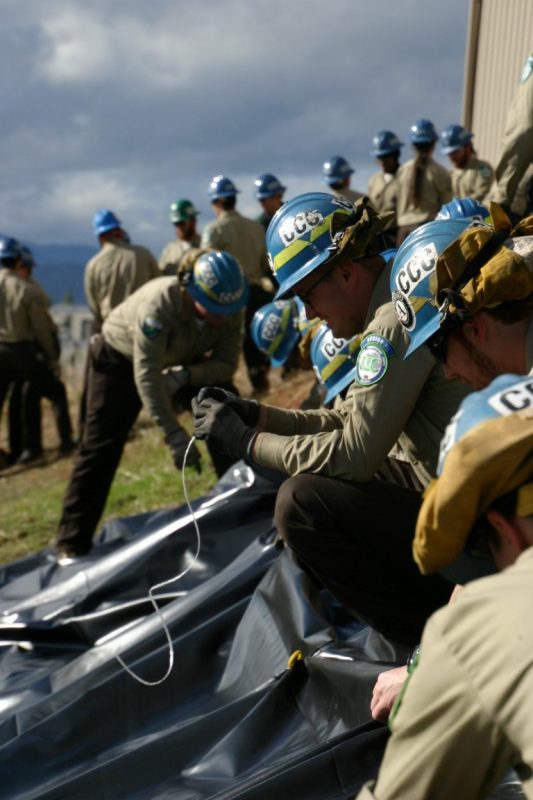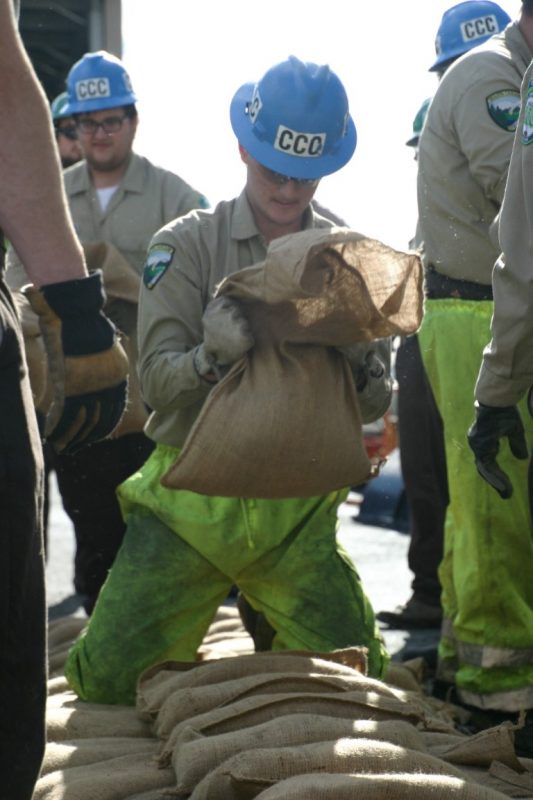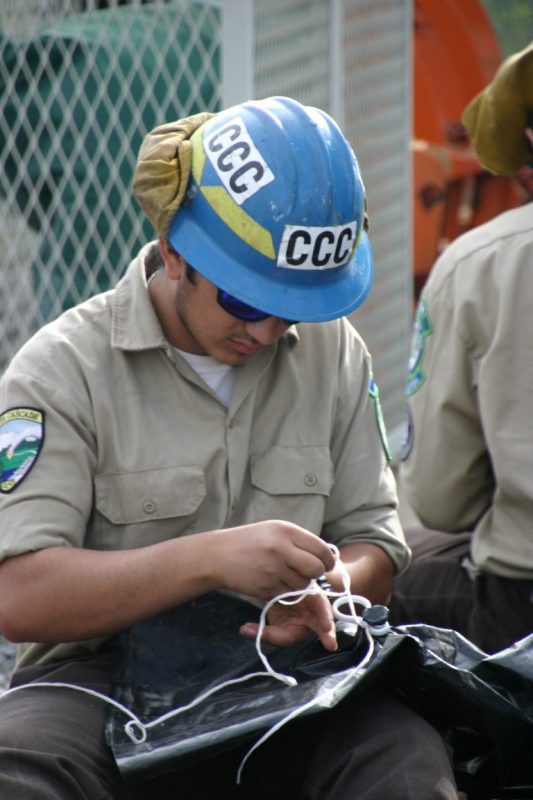When the fall rains came, they brought an official end to the disastrous 2017 fire season in California. They also brought a reminder of another of California’s potential natural disasters—floods.
California Conservation Corps crews around the north state have been training for flood response. Seven crews involving about 100 Corpsmembers from Redding, Chico and Yreka assembled at a Redding CalTrans maintenance yard on November 16 to learn the essentials of filling, moving and laying sandbags. The crews rotated around five different work stations to learn each of five essential skills of flood fighting.
There is more to sandbagging than you might think. The sandbags must not be filled too much, or they will not fit together snugly to build waterproofs walls. It might look easy to carry one of these properly filled sandbags a few yards, but when repeated for thousands of sandbags over a 12-hour shift, proper techniques will prevent injuries and keep Corpsmembers going through those long hours. Corpsmembers learned how to form lines to chain sandbags from one location to another. They learned how to communicate with one another to keep everyone’s attention focused on the work at hand.
Corpsmembers also learned what to do with those sandbags once the sandbags arrived at the worksite. They learned how to stack them into solid walls. One layer of sandbags is laid. The sandbags are fitted snugly together, with the tops folded over against the water flow so that the sand is not washed out of the bags. For the next layer, the joints between sandbags are staggered with the joints of the lower layer. In brick laying this is called ‘breaking the joint’, and it results in a strong wall. Then the sandbags are walked on, pushing them firmly into place and forcing them to fit snugly together. This is why the sandbags cannot be too full of sand. They could not be form-fitted as snugly if they are full of sand.
Corpsmembers learned how to build sandbags up into walls to make a levy higher against rising water. They also learned how to lay sandbags into rings and horseshoes to prevent leaks called ‘boils’ from becoming levy breaches.
The flood-fighters-in-training also learned how to lay sheets of plastic across a levy to protect the soil from the pounding of wind-driven waves, or wave wash. These sheets are secured with sandbags and a crisscross of string to hold the plastic securely in place, even in the event of 70-mile-an-hour winds. In 1997, Corpsmembers working floods down in the Delta laid 300 feet of plastic to protect a section of levy on Webb Tract from waves building up across the open water of Franks Tract. Weather instruments on a nearby river barge indicated the wind speed exceeded 70 knots. The plastic wave wash protection lasted more than six hours until the winds receded, and surely saved that section of levy from failure.
A key step in securing the plastic and sandbags is knowing how to attach the string to the plastic without letting the plastic rip, either when tying the string on, or by the howling winds pulling at the plastic once in place. The Department of Water Resources has developed a plastic button/frame combination that is the most efficient method for securing string to the plastic. One station in the day’s training was dedicated to learning the knots and methods for securing these buttons.
They also learned how to secure a building from rising waters with plastic and sandbags. Once the skills of laying sandbags and sheet plastic have been learned for wall construction and wave wash protection, this is a simple process. The plastic is laid in an ‘L’ shape against the building and the ground. Pieces of duct tape can be used to hold the plastic up against the wall. Then sandbags are properly laid and stacked to hold the plastic in place against the water.
CCC centers in Ukiah and South Lake Tahoe also conducted flood training before the Thanksgiving holiday. Similar flood training has occurred at CCC centers around the state.
The CCC is a work program for young adults from 18-25. They sign up for one year, and can extend to pursue promotion or opportunities in special programs like firefighting or Back-country trails. The nature of the program means that most corpsmembers won’t be around for more than a year. Only a handful of these Corpsmembers were around during flood season last year. They filled sandbags and worked at the evacuation center on the Oroville Dam emergency. The nature of Corpsmember attrition makes these annual trainings necessary to keep the crews fully prepared. The Redding training was led by two experienced CCC staff members: C2 (Project Coordinator) Shawn Fry, and C1 (Crew Supervisor) Stacy Borowski. Stacy has worked on eight flood events going back to the massive 1997 flood response, at which more than 20 crews from all over California were staged at the former Delta Center in Stockton and spent weeks responding to widespread flooding throughout the Delta.
The Shasta-Cascade District crews have finished their summer projects for the year. Redding crews spent last summer camped out near Graeagle and Desolation Wilderness for long-term trails projects. Other Redding crews also responded to fires over the summer. One of those crews is a specialized fire crew that works on the fire lines. Other crews worked fire camp support in jobs such as supply and facilities maintenance. They will now spend the winter working closer to home with CalTrans landscape maintenance projects and various natural resource projects for various state and Federal agencies.
For more photos of the 2017 flood training in Redding, or to read more stories of the CCC, please go to CCC: Hard Corps.
If you are between the ages of 18-25 and would like to find out about joining this winning team, or for other information about the CCC, please visit the California Conservation Corps’ website.
 George T. Parker is a former CCC Corpsmember. He has been working in natural resources since coming to California in 1986, and the CCC was the gateway to that career path. George’s passion is telling the story of the CCC and its Corpsmembers at the blog CCC: Hard Corps. He currently lives near Redding with his family.
George T. Parker is a former CCC Corpsmember. He has been working in natural resources since coming to California in 1986, and the CCC was the gateway to that career path. George’s passion is telling the story of the CCC and its Corpsmembers at the blog CCC: Hard Corps. He currently lives near Redding with his family.









